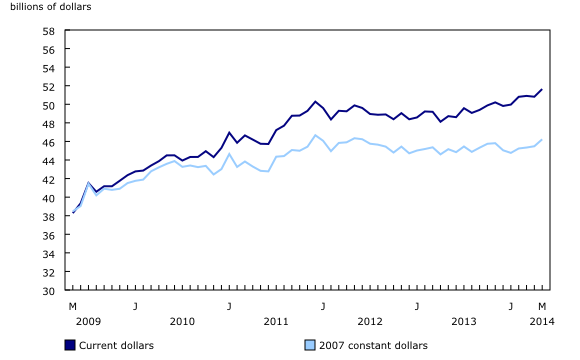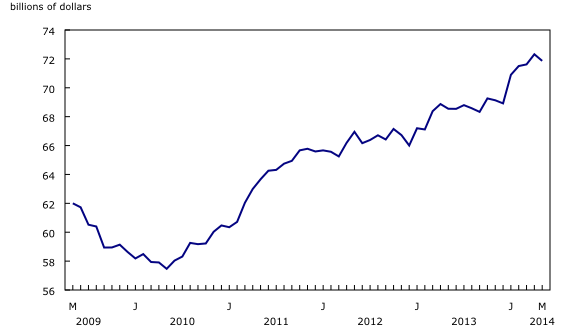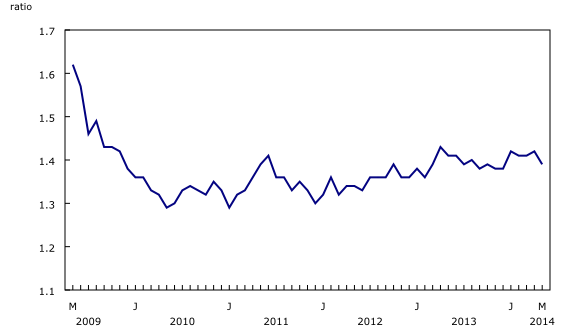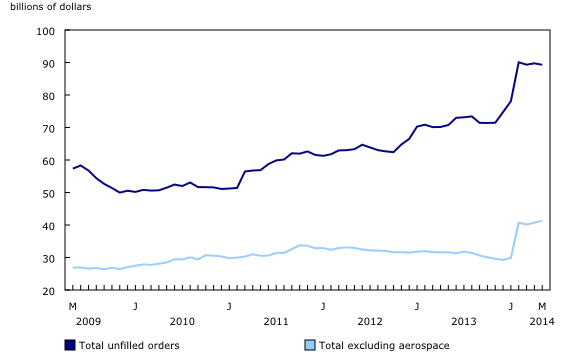Monthly Survey of Manufacturing, May 2014
Archived Content
Information identified as archived is provided for reference, research or recordkeeping purposes. It is not subject to the Government of Canada Web Standards and has not been altered or updated since it was archived. Please "contact us" to request a format other than those available.
Released: 2014-07-16
Manufacturing sales rose 1.6% to $51.6 billion in May, the fourth increase in five months. The gain was largely due to higher sales in the petroleum and coal product and motor vehicle industries.
Sales rose in 11 of 21 industries, representing about 61% of the manufacturing sector.
Constant dollar sales were also up 1.6% in May, indicating a rise in the volume of goods sold.
Sales rise in the petroleum and coal and motor vehicle industries
In the petroleum and coal product industry, sales increased 7.2% to $7.4 billion in May. The gain reflected a return to more normal sales levels at several refineries following partial shutdowns in April for maintenance and retooling work.
Sales in the motor vehicle industry increased 9.3% to $4.9 billion, reaching the highest level since January 2012. Sales at some plants returned to normal levels after shutdowns for part of April.
Primary metal sales rose 2.4% to $3.9 billion in May. Gains in the industry were widespread.
A 2.0% decline in the food industry offset some of the gains in May. One factor behind the decrease was lower than normal sales in the seafood product preparation and packaging industry.
Ontario manufacturing sales increase
Manufacturing sales rose in six provinces in May, with almost two-thirds of the gain concentrated in Ontario.
In Ontario, sales rose 2.3% to $24.1 billion, the fourth consecutive increase for the province. With the latest advance, sales reached their highest level since July 2008, before the last recession. Most of the gain in May was caused by higher sales in the motor vehicle industry.
Sales in New Brunswick rose 15.8% to $1.6 billion, following six months of declines. Higher non-durable goods sales were the primary factor behind the gain.
The manufacturing sector in Alberta posted a 1.6% increase to $6.7 billion in sales. The rise was the fifth consecutive monthly advance for the province. The gain in May stemmed from higher petroleum and coal product sales.
In Newfoundland and Labrador, sales declined 11.3% to $488 million. Manufacturing sales in the province tend to be more volatile compared with other provinces. The decline reflected lower sales of non-durable goods.
Quebec manufacturing edged down 0.4% to $11.8 billion in May. Declines in the food and paper industries were partly offset by higher primary metal sales.
Inventories decrease
Inventories declined 0.6% to $71.9 billion in May, the first decline in five months. The decrease in May was largely a result of lower inventories held by petroleum and coal product manufacturers.
In the petroleum and coal product industry, inventories dropped 7.1% to $6.9 billion. Most of the decline reflected lower raw materials on hand at some plants.
Transportation equipment inventories declined 0.9% to $12.8 billion in May. The decrease was caused by lower inventories in the motor vehicle as well as other transportation equipment industries.
The declines were partly offset by a 1.4% gain in primary metal inventories and a 1.5% increase in the chemical industry.
The inventory-to-sales ratio decreased from 1.42 in April to 1.39 in May, its lowest level since December 2013. The ratio measures the time, in months, that would be required to exhaust inventories if sales were to remain at their current level.
Unfilled orders decline
Unfilled orders were down 0.5% to $89.3 billion in May as a result of a decline in the aerospace product and parts industry. Higher unfilled orders in the machinery and primary metal industries offset part of the decline.
In the aerospace product and parts industry, unfilled orders decreased 2.2% to $47.9 billion in May. Part of the decrease reflected a 0.8% gain in the value of the Canadian dollar relative to the US dollar. Most unfilled orders in the aerospace industry are held in US dollars.
Unfilled orders rose 6.8% to $7.2 billion in the machinery industry, the fourth increase in five months. With the advance in May, unfilled orders for the industry reached their highest level since July 2013. In the primary metal industry, unfilled orders advanced 20.1%, reaching their highest level since November 2008.
New orders edged down 0.1% to $51.2 billion. Declines in the transportation equipment and food industries were largely offset by gains in the petroleum and coal product and primary metal industries.
Note to readers
Monthly data in this release are seasonally adjusted and expressed in current dollars unless otherwise specified. With this release, data for the previous three months have been revised.
Non-durable goods industries include food, beverage and tobacco products, textile mills, textile product mills, clothing, leather and allied products, paper, printing and related support activities, petroleum and coal products, chemicals, and plastics and rubber products.
Durable goods industries include wood products, non-metallic mineral products, primary metal, fabricated metal products, machinery, computer and electronic products, electrical equipment, appliances and components, transportation equipment, furniture and related products and miscellaneous manufacturing.
Production-based industries
For the aerospace industry and shipbuilding industries, the value of production is used instead of sales of goods manufactured. This value is calculated by adjusting monthly sales of goods manufactured by the monthly change in inventories of goods in process and finished products manufactured.
Unfilled orders are a stock of orders that will contribute to future sales assuming that the orders are not cancelled.
New orders are those received whether sold in the current month or not. New orders are measured as the sum of sales for the current month plus the change in unfilled orders from the previous month to the current month.
Manufacturers reporting in US dollars
Some Canadian manufacturers report sales, inventories and unfilled orders in US dollars. These data are then converted to Canadian dollars as part of the data production cycle.
For sales, based on the assumption that they occur throughout the month, the average monthly exchange rate for the reference month (noon spot rate) established by the Bank of Canada is used for the conversion. The monthly average exchange rate is available in CANSIM Table 176-0064.
Inventories and unfilled orders are reported at the end of the reference period. Therefore, for these variables, the noon spot exchange rate on the last working day of the month is used for the conversion. The noon spot exchange rate is available in CANSIM Table 176-0067. Note that because of exchange rate fluctuations, the monthly average exchange rate can differ substantially from the exchange rate on the last working day of the month.
Data from the June Monthly Survey of Manufacturing will be released on August 15.
Contact information
For more information, contact us (toll-free 1-800-263-1136; 514-283-8300; infostats@statcan.gc.ca).
To enquire about the concepts, methods or data quality of this release, contact Michael Schimpf (613-951-9832; michael.schimpf@statcan.gc.ca), Manufacturing and Wholesale Trade Division.
- Date modified:





